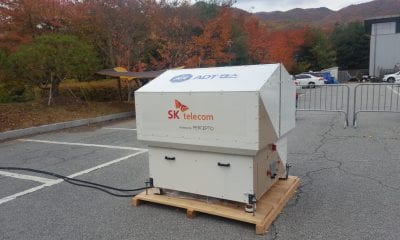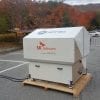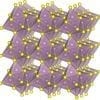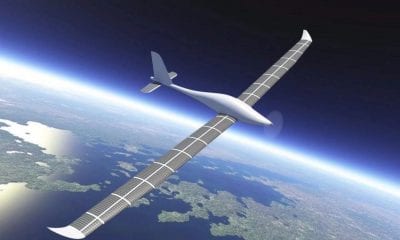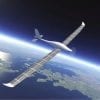
News
Ultra-Wide Angle Solar Collection for Drones, Planes and Cars
Ultra-Wide Angle Solar Collection for Drones, Planes and Cars
What a confusing title that is. Let’s start simple.
With the increasing worldwide concern regarding energy generation and renewable energy sources, governments are looking towards cheap energy generation methods that don’t consume as much natural non-renewable resources and don’t harm the environment.
Coal fired power plants and nuclear power plants, while effective and efficient as far as power generation is considered, consume precious resources like natural coal and nuclear material and at the same time, pollute the environment.
The most convenient modern solution to solve the problem of cheap and safe energy generation is the usage of solar panels; easy enough to be integrated with any building, roadside, product, vehicle; solar panels are a hot topic of research all over the world.
With mechanical engineers researching the heat generation from solar panels, electrical engineers improving the efficiency of solar power plants, software engineers optimizing the angles of solar panels in the environment to maximize power generation and electronics engineers working on the design of a solar panel and a photovoltaic cell, the knowledge and application scope of solar panels is certainly expanding exponentially.
Wait, what are photovoltaic cells?
Photovoltaic cells are what solar panels are made of. Photovoltaic, as the name clearly suggests, means generation of voltage or electricity from light. Made of flat chips of semi-conductor materials like Silicon, a solar panel is a collection of tiny photovoltaic cells exposed to sunlight.
So what sort of research is done to improve the working of photo-voltaic cells?
We of course maximize the efficiency of a single cell so that it would create more energy in less time and less light intensity, we certainly optimize the angle of solar panels against sun rays to make sure that the solar panel is fully exposed to sunlight; optimization of the angle of a solar panel is quite convenient if it is to be done in a solar plant as the solar panels are attached to stationary supports that move with the progression of time throughout the day such that the panel continuously faces the sun. However, the same traditional approach is not applicable to most modern applications such as solar powered drones, planes, cars bikes and robots.
The research publication Ultra-wide angle solar collection top-layer for commercial photo-voltaic panels by Rakan Alsaigh, Raulf Bauer and Martin Lavery implements a novel approach towards solving the problem that is optimization of the solar panels as per the location of the sun.
Their Solution: They present a novel approach that combines a commercial photovoltaic panel fitted with a 3D-printed ultra-wide viewing angle lens-let array top-layer to give over 100% gain in the open circuit voltage produced by the panel at an incidence angle of 75 degrees, with no significant losses at normal incidence, leading to a full hemispheric gain of 15.6%.

Ultra – wide angle top – layer optical element. A Schematic illustration of the system arrangement, with the optical element on – top of a PV panel. The optical element consists of two face – to – face layers of 2mm diameter hemispheric lens – let arrays that sit on a 2mm thick base. Simulated incident rays are displayed at 0° angle of incidence with transmitted rays at angles up to 50°. The angle of the transmitted rays is largely dependent on the position at which the incident rays hit the top hemispheric lens. B Schematic illustration of the system with simulated rays at incident angle of 60°
Simulation Results: Comsol Multiphysics was used to create a 2D ray tracing simulation of the double lens-let array. The lens-lets were modelled using a CAD design. The ray power at the input plane of the solar panel was accumulated over the full time steps for each orientation, combined with the incident angle of each ray being guided to the solar panel interface. This confirmed the transformation of incident angles into the panel’s conversion range; essentially verifying the effectiveness achieved with the use of the double lens-let array.
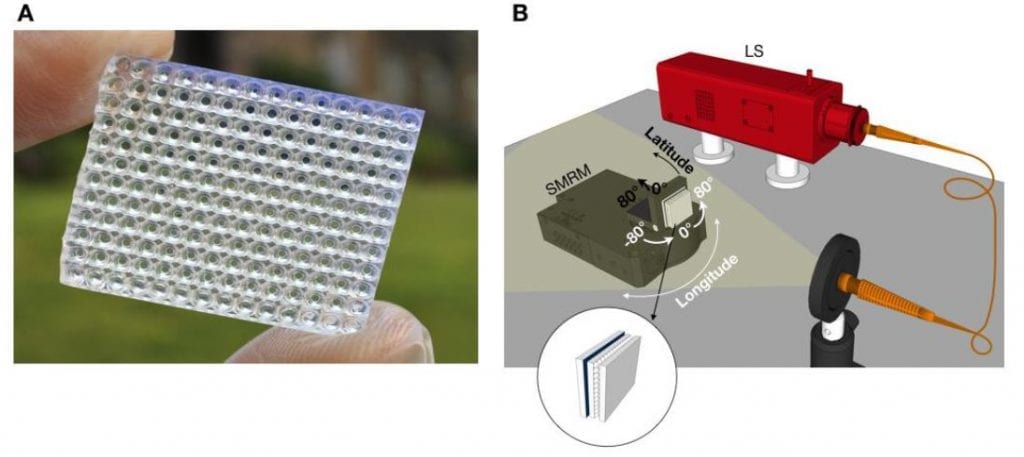
3D – printed top – layer optical element. A Image of the 3D – printed optical prototype of our ultra – wide angle design. B Illustration of the testing set – up, showing a fiber – coupled stabilised broadband light source (LS) illuminates a 15cm – diameter beam at the optical element’s plane. The optical element is on – top of an amorphous Si solar panel that is back – attached to a tilt – adjustable rotational mount driven by a stepper motor (SMRM).
Reference: arXiv:1808.06973 [physics.app-ph] https://arxiv.org/abs/1808.06973

